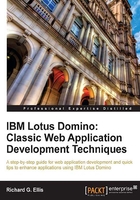
Preface
Boss: I need some web pages up as soon as you can.
Developer: No problem. I'll get you something before lunch.
Creating web pages was fairly straight-forward in the early 1990's. Today, there are many, often competing technologies available for creating a web experience. Remarkably, all these differing technologies and strategies interoperate in a relatively seamless way to serve the billions of people who use the World Wide Web and the Internet.
IBM's Lotus Notes and Domino product set the subject of this book is a feature-rich, application development technology that has been used to create web-enabled applications since the late 1990's. Since then, it has evolved substantially through several major software versions, and it will continue to advance into the foreseeable future, adapting to the changing web landscape and incorporating new technologies and methods as appropriate.
One of the delightful aspects of Domino is its backwards compatibility. With few or no changes, applications written with previous versions of the software, untouched for a decade or more, will run as expected on the newest Domino server.
It is also important to understand that useful applications can be crafted and deployed on a wide range of platforms with relatively little work. A simple application can be cobbled together and rolled out in less than an hour. It would not be a complex application, of course, but it might suffice for basic data collection or an informational website. After that first version rolls to production, providing immediate benefit to users, features and improvements could be added incrementally with little or no downtime.
Quickly-crafted applications are probably not polished applications in terms of look-and-feel or function. This author has worked with a number of these earlier, rapidly-developed applications; they are still functional, but by contemporary web standards, they are not pretty.
Improving an existing, web-enabled application comes with a number of challenges. How can the design be upgraded without impacting users or disturbing the data?
It was in facing the challenge of working with some of these older applications that I first began making notes which led to this publication.